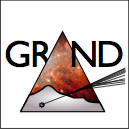Session « neutrino detection simulation »
Monday, Feb 9.
A key element to evaluate the pertinence of a giant radio array for cosmic neutrino search is obviously to assess its detection potential for these particles. This requires a dedicated end-to-end Monte-Carlo simulation. The detection scenario is far for straightforward [neutrino interaction in rock, tau propagation in rock and air, tau disintegration, horizontal shower development, radio emission, antenna response and array trigger], and numerous uncertainties arise at most stages. Atop of that, CPU needs for a MC simulation over such a large array (~100’000 detection units) represents an additional challenge. We propose to divide the session as follows:
In a first part (11h-13h00), focus will be put on the simulation chain down to air shower generation. Status of the neutrino search by the AUGER experiment will in particular be presented as well as the preliminary (and incomplete) simulation performed by members of the TREND project to estimate GRAND’s neutrino sensitivity.
In a second part (14h30-16h00), aspects related to the specific issue of radio simulation will be studied. The CoREAS and Selfast radio simulation codes will be presented, with a specific emphasis on the estimation of the radio detection range for (very) old and ~horizontal showers, as well as reflexion on ground. We will finally discuss what it would take to implement a realistic, robust and fast end-to-end MC to provide a reliable neutrino sensitivity estimate.
Session “Air Shower radio-detection”
Tuesday, Feb 10.
Here we will talk about the experimental status of air shower radio-detection, and more specifically how air showers can be distinguished from the overwhelmingly dominant electromagnetic background.
In a first part (9h-10h30), the state of the art of radio-antennas antennas dedicated to air showers radio detection will be detailed, as well as most recent results by the CODALEMA and AERA experiments. A specific emphasis will be put on the polarization feature of radio-signals associated to air showers, as it may constitute a very specific signature. Results of TREND[1], a sino-french project on autonomous air shower radio detection, will also be presented.
In a second part (10h50-12h20), we will focus on GRAND-proto, a prototype setup derived from TREND, composed of an array of 35 3-arms antennas and 20 scintillators. The radio array should allow a complete determination of the polarization information for all triggered antennas. Radio-events with a polarization signature compatible with an air shower will be cross-checked in the scintillator data, allowing for a quantitative evaluation of the potential for air-shower identification of a measurement of the polarization on an event-by-event basis. It is expected that GRAND-proto will help us determine if air shower identification through polarization measurement is reliable enough to adapt this method to the search of neutrino-induced air showers in the GRAND telescope.
The GRAND-proto array shall be deployed between summer 2015 and summer 2016 on the TREND site. Concept, design and status of the of this project will be detailed in this session.
Session “GRAND array: detector design”
Tuesday, Feb 10.
Here we propose to discuss on the design of the GRAND array. An array of 90 000 detection units over 60000km² is obviously a huge technical challenge, but maybe not unrealistic. Proposals for a unit design or communication within the array, even if at a very early stage, will be presented and discussed.
Feedback on the deployment and maintenance of AUGER -the largest detector in the world- will certainly be enlightening. The possible support of the Ulastai Observatory to GRAND will also be detailed.
Session “Experimental input from other neutrino detectors”
Tuesday, Feb 10.
The objective of this session is to gather technical and scientific input from existing and planned neutrino detectors. Experts from ANITA, ARA, ANTARES and KM3Net will highlight the workings and specificities of their instruments, and the problems encountered. A discussion to assess how these features could apply to GRAND will follow.
Session “other science cases”
Monday, Feb 9 and Wednesday, Feb. 11.
This session aims at identifying other potential uses of the GRAND detector, in order to expand the science case of the experiment. The Monday afternoon session will be devoted to the study of the Epoch of Reionization with the 21cm neutral hydrogen emission line (see below). At the Wednesday session, with a clearer view of the design of GRAND, we hope to gather new ideas for other applications.
Monday session (16:30-18:00): The 21cm neutral hydrogen emission line represents an interesting tool to study the apparition of the first stars, as the ignition of the nuclear processes inside the stars coming to life must have induced the re-ionization of the surrounding hydrogen gaz. Because of the expansion of the Universe, the 21cm radiation at the Epoch of Reionization is supposed to correspond to the 50-200MHz frequency range in the present days. This range is similar to that of extensive air showers electromagnetic emission. There is therefore a natural connection between the 2 fields of research; The physics of the Epoch of Reionzation, as well as the status of simulations and experiments will be reviewed.
[1]
[1] Tianshan Radio Array for Neutrino Detection

